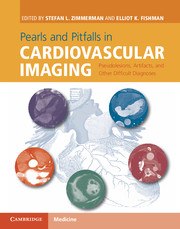 Pearls and Pitfalls in Cardiovascular Imaging
Pearls and Pitfalls in Cardiovascular Imaging Book contents
- Frontmatter
- Contents
- List of contributors
- Preface
- Section 1 Cardiac pseudotumors and other challenging diagnoses
- Section 2 Cardiac aneurysms and diverticula
- Section 3 Anatomic variants and congenital lesions
- Section 4 Coronary arteries
- Section 5 Pulmonary arteries
- Case 42 Pitfalls in obtaining optimal vascular contrast for pulmonary embolism examinations
- Case 43 Artifacts mimicking pulmonary embolism
- Case 44 Pulmonary artery imaging for pulmonary embolism in patients with Fontan shunt for congenital heart disease
- Case 45 Pulmonary arteriovenous malformations
- Case 46 Pulmonary artery sarcoma
- Section 6 Cardiovascular MRI artifacts
- Section 7 Acute aorta and aortic aneurysms
- Section 8 Post-operative aorta
- Section 9 Mesenteric vascular
- Section 10 Peripheral vascular
- Section 11 Veins
- Index
- References
Case 43 - Artifacts mimicking pulmonary embolism
from Section 5 - Pulmonary arteries
Published online by Cambridge University Press: 05 June 2015
- Frontmatter
- Contents
- List of contributors
- Preface
- Section 1 Cardiac pseudotumors and other challenging diagnoses
- Section 2 Cardiac aneurysms and diverticula
- Section 3 Anatomic variants and congenital lesions
- Section 4 Coronary arteries
- Section 5 Pulmonary arteries
- Case 42 Pitfalls in obtaining optimal vascular contrast for pulmonary embolism examinations
- Case 43 Artifacts mimicking pulmonary embolism
- Case 44 Pulmonary artery imaging for pulmonary embolism in patients with Fontan shunt for congenital heart disease
- Case 45 Pulmonary arteriovenous malformations
- Case 46 Pulmonary artery sarcoma
- Section 6 Cardiovascular MRI artifacts
- Section 7 Acute aorta and aortic aneurysms
- Section 8 Post-operative aorta
- Section 9 Mesenteric vascular
- Section 10 Peripheral vascular
- Section 11 Veins
- Index
- References
Summary
Imaging description
Different artifacts that hamper interpretation during pulmonary artery CT include mixing or flow artifact (also called interrupted contrast enhancement) mimicking a pulmonary embolism, respiratory motion artifact resulting in linear decreased enhancement in segmental arteries that also simulates embolism on axial sections, cardiac motion artifact creating pseudodissection, and beam hardening artifact from dense contrast in the SVC obscuring visualization of the right pulmonary arteries. Owing to poor cardiac output, unopacified and opacified contrast mixed in the main and segmental arteries, mimic pulmonary embolism (Figure 43.1). Contrast enhancement is optimized by using bolus tracking software to tailor the scan timing to the patient's cardiopulmonary status, as described in case 42, and by administering contrast at higher infusion rates. Additionally, a number of studies have reported that hyperventilating the patient and imaging in deep inspiration contribute to flow artifacts that mimic emboli. Expiratory scanning reduces the incidence of focal diminished contrast enhancement and results in higher pulmonary artery enhancement levels.
A more common cause of pseudothrombus is motion artifact (Figure 43.2). Correlation with coronal MPR reveals linear decreased attenuation parallel to the transverse plane secondary to respiratory motion artifact, which underscores the importance of correlating axial findings with MPRs.
Faster scanners (128 slice and beyond) aid in reduction of both cardiac and respiratory motion artifacts. If pulmonary artery dissection is suspected, identification of linear pulsation artifact within other cardiac structures (i.e., aorta) increases confidence that the finding is due to cardiac motion. Finally, the beam-hardening artifact in the superior vena cava, which sends streaks of high density across the right pulmonary arteries, can be reduced by administering a saline chaser after the contrast bolus.
Importance
Interpretation of pulmonary artery CTA requires protocol optimization to maximize contrast enhancement and minimize artifacts. Ideally, protocol design results in a high-quality dataset with excellent pulmonary artery enhancement and absence of these artifacts. In practice, however, image quality is not always perfect.
Information
- Type
- Chapter
- Information
- Pearls and Pitfalls in Cardiovascular ImagingPseudolesions, Artifacts, and Other Difficult Diagnoses, pp. 134 - 136Publisher: Cambridge University PressPrint publication year: 2015
References
Accessibility standard: Unknown
- 1
- Cited by